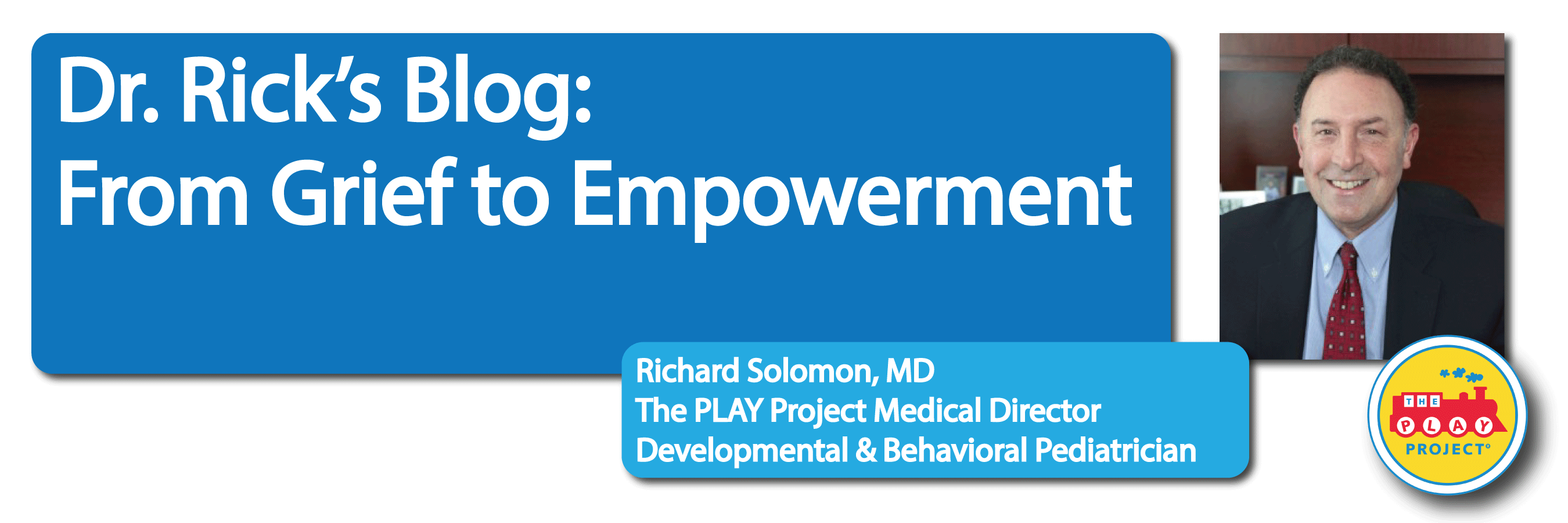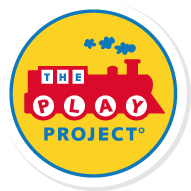
Richard Solomon, MD
9/13/16
I just watched a little girl, I’ll call her Addy (not her real name), on a home visit video as her family was starting the PLAY Project Autism Intervention program. She was so adorable! Blond, 3 years old and very hard to engage. As a supervisor of PLAY Consultants in training, I watch a lot of videos like this. Little Addy ran around the backyard patio as if running away from her parents. I watched with sadness as the dad, then the mom tried to engage Addy and couldn’t.
In the PLAY Project’s autism Intervention program, it is our job to help parents engage their hard to engage children. We have four principles: 1. Having fun with people, 2. Putting in the time of 2-3 hours per day of PLAY, 3. Creating a developmental profile of each child’s individuality, 4. So parents learn to play at the just right level. We tell the parents, “Put away the toys and you be the toy.” Some of our parents have forgotten how to play! But we’re good at empowering parents to be silly, rough-housers, and jokesters until parents in The PLAY Project learn how to be fun players. When it comes to putting in the time, even a single parent working full time spends 45 waking hours with her children. When we empower parents to make ‘every interaction a good interaction’, they report that they don’t feel like they are ‘doing therapy’. They are just having fun interacting with their child. Parents tell us that this feeling of being their child’s best play partner is exhilarating.
But playing with a child who has autism is not easy—especially in the beginning. Empowerment must pass through grief.
Our hardest job is to get parents to lower their level of play to meet their child exactly where they’re at developmentally. Bob and Judy, Addy’s parents, wanted to play at too high of a level. They tried ‘chase’; they tried ‘hide and seek’. Addy just didn’t get it. I understand why parents play too high. They play ‘normal’ games because that’s what they know how to do. Parent are also very ambitious for their child. They want talking, academic readiness, college, work, and marriage! And I want those things for their children too. I just know from decades of working with children on the spectrum that first you must get to the essence of relationship—shared attention, engagement, and interaction. With Addy we had to coach the parents to simply run aimlessly by her side. Addy’s dad, Bob, actually said (on camera), “Is this going to help her?”
To help engage the hard to engage child, we promote five methods that are initially hard for parents to do (I’ll explain why below). The first method is to understand the child’s intention by carefully watching his or her gestures and the second method is then to follow those gestures, and the intention behind them, by doing what the child wants (not what the parent wants!) The third method Is to wait, wait, wait—one of the hardest things for parents because they want to do, do, do. But waiting allows the child with autism to respond, to initiate toward the parent. Those precious overtures—eye contact, gestures for more, laughing and joyful interactions—that say to a parent “I know you are here.” are like finding gold. Often, while I’m watching the videos, there is that moment of surprise: As Judy ran by Addy’s side Addy started to look for her to see if she was running with her. Mom said: “Did you see that?! She looked at me.” The PLAY Consultant on camera said: ‘You did what she wanted and she wants more.” That’s method 4, getting interactions, what we call ‘circles of communication’—the back and forth of communication. The last method is expanding on the child’s idea, adding a little twist on the play in a way that’s fun. By running with Addy around the patio, Addy looked up at daddy—a most beautiful smile—that said, “Thanks dad for joining me. I’m having fun with you.” Daddy reached out his hand—he expanded the play—and Addy reached for him. You should have seen the joy on his face!
Through our principles and methods, we are coaching parents to do one of the hardest things they will ever do: come face to face with autism itself. We coach parents to be with autism, to join the autism, to accept the autism and this often causes feelings of sadness and grief. One parent recently said to me “Those first few months were so hard. I thought she would never connect with us. I felt so sad. But then, when she started to look and connect, I was so happy. Now she won’t leave us alone!” As I always say: “When you accept your child right where he or she is at, that’s the fastest way to help them become the child you want them to be.” Acceptance, ironically, leads to progress.
And progress leads to doubts. Will she or he make it to the next developmental milestone? Some children are slow movers, some medium movers, some fast movers. No matter how fast or slow the child moves, though, he or she must climb the same developmental ladder. To use a house metaphor, the first interactions are like placing bricks one by one slowly to build the foundation and the walls. It’s tedious and not very rewarding. When the walls are built, however, receptive language emerges, then meaningful gestures and finally first words. With the roof, so to speak, comes pretend play, talking in short sentences, playing games. Finally we furnish the home with emotional thinking and, ultimately, friendship. Parents tell us: At first, it seemed like playing with our child would never get us what we wanted—talking, being social, school readiness—but I can tell you from following thousands of children that the potential within these children is extraordinary.
Little Addy was a ‘medium mover’ who over 6 months made very good progress. She was no longer hard to engage. In fact, we had created a monster and she wouldn’t leave her parents alone! She loved to play with her mom and dad and even her little brother. She had a few words. She was developing a good of humor and starting to enjoy simple slapstick pretend. “Me eat Addy’s toes!” said the Cookie Monster puppet, “Num, num, num. Me like Addy’s toes!” And Addy liked Cookie eating her toes. She offered one foot and then another!
But an even bigger transformation happened with the parents. Bob and Judy had evolved from not really knowing how to engage Addy, to being skillful players. They were fun! They were confident in their ability to engage Addy. It was joy for me to watch them on follow up videos. They were empowered!
Let me end this blog with another aspect of grief and empowerment. I travel the country and see what is happening in state after state. And the ‘state’ of autism intervention is grievous. There are too many children on waiting lists. Why? Only one type of treatment, called ABA (Applied Behavior Analysis) is offered in most states. This treatment has good evidence but it is delivered by therapists 20-30 hours per week, not by parents. Big programs can only take care of 50 children at a time while hundreds wait for services. This is a real shame (and bad public policy!) especially when parents can be so effective in helping their own children. We need to have parent implemented autism intervention models much more readily available in this country so families like Addy’s can be empowered to engage their hard to engage children; to have the joy of being their child’s best play partner; to know that they, the parents, made a difference in their child’s life.
